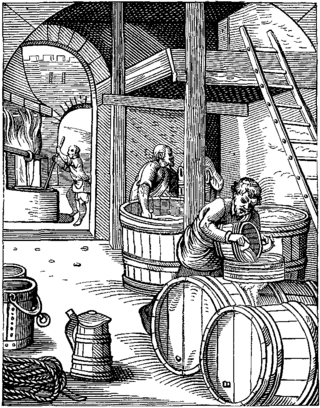
Brewing is the production of beer by steeping a starch source in water and fermenting the resulting sweet liquid with yeast. It may be done in a brewery by a commercial brewer, at home by a homebrewer, or communally. Brewing has taken place since around the 6th millennium BC, and archaeological evidence suggests that emerging civilizations, including ancient Egypt, China, and Mesopotamia, brewed beer. Since the nineteenth century the brewing industry has been part of most western economies.

Salami is a cured sausage consisting of fermented and air-dried meat, typically pork. Historically, salami was popular among Southern, Eastern, and Central European peasants because it can be stored at room temperature for up to 45 days once cut, supplementing a potentially meager or inconsistent supply of fresh meat. Countries and regions across Europe make their own traditional varieties of salami.

Sauerkraut is finely cut raw cabbage that has been fermented by various lactic acid bacteria. It has a long shelf life and a distinctive sour flavor, both of which result from the lactic acid formed when the bacteria ferment the sugars in the cabbage leaves.

Kombucha is a fermented, lightly effervescent, sweetened black tea drink commonly consumed for its purported health benefits. Sometimes the beverage is called kombucha tea to distinguish it from the culture of bacteria and yeast. Juice, spices, fruit or other flavorings are often added.

Nattō, spelled as natto in standard English language use, is a traditional Japanese food made from whole soybeans that have been fermented with Bacillus subtilis var. natto. It is often served as a breakfast food with rice. It is served with karashi mustard, soy or tare sauce, and sometimes Japanese bunching onion. Within Japan, nattō is most popular in the eastern regions, including Kantō, Tōhoku, and Hokkaido.

Cheesemaking is the craft of making cheese. The production of cheese, like many other food preservation processes, allows the nutritional and economic value of a food material, in this case milk, to be preserved in concentrated form. Cheesemaking allows the production of the cheese with diverse flavors and consistencies.
Balché is a mildly intoxicating beverage that was commonly consumed by the ancient Maya in what is now Mexico and upper Central America. Today, it is still common among the Yucatec Maya. The drink is made from the bark of a leguminous tree, Lonchocarpus violaceus, which is soaked in honey and water, and fermented. A closely related beverage, made from honey produced from the nectar of a species of morning glory (Turbina corymbosa), is called xtabentún.

Pickling is the process of preserving or extending the shelf life of food by either anaerobic fermentation in brine or immersion in vinegar. The pickling procedure typically affects the food's texture and flavor. The resulting food is called a pickle, or, to prevent ambiguity, prefaced with pickled. Foods that are pickled include vegetables, fruits, mushrooms, meats, fish, dairy and eggs.

Ayran, doogh, dhallë, daw, shaneena, xynogala or tan is a cold savory yogurt-based beverage of Turco-Mongolian origin, popular across Central Asia, West Asia, Southeastern Europe, North Asia and Eastern Europe. The principal ingredients are yogurt, water and salt. Herbs such as mint may be optionally added. Some varieties are carbonated. Ayran is notably quite popular in Iran.

Fermentation is a metabolic process that produces chemical changes in organic substances through the action of enzymes. In biochemistry, it is narrowly defined as the extraction of energy from carbohydrates in the absence of oxygen. In food production, it may more broadly refer to any process in which the activity of microorganisms brings about a desirable change to a foodstuff or beverage. The science of fermentation is known as zymology.
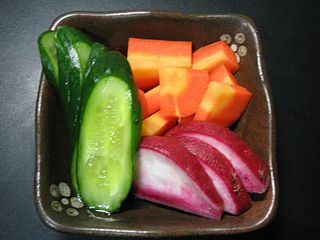
Nukazuke (糠漬け) is a type of Japanese preserved food, made by fermenting vegetables in rice bran (nuka), developed in the 17th century.
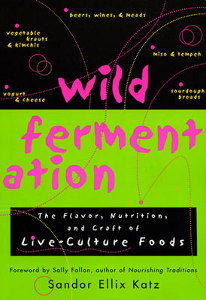
Wild Fermentation: The Flavor, Nutrition, and Craft of Live-Culture Foods is a 2003 book by Sandor Katz that discusses the ancient practice of fermentation. While most of the conventional literature assumes the use of modern technology, Wild Fermentation focuses more on the practice and culture of fermenting food.
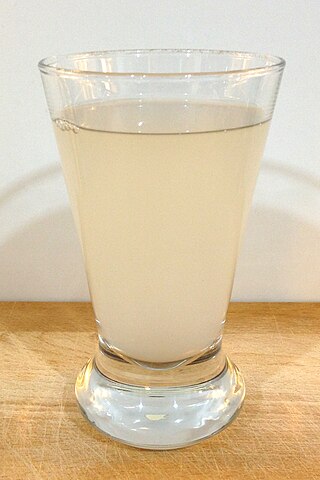
Rejuvelac is a kind of grain water that was invented and promoted by Ann Wigmore, born in Cropos, Lithuania. The beverage is closely related to a traditional Romanian drink, called borș, a fermented wheat bran that can be used to make a sour soup called ciorbă or as the basis for Vegan cheeses.

Roadkill cuisine is preparing and eating roadkill, animals hit by vehicles and found along roads.
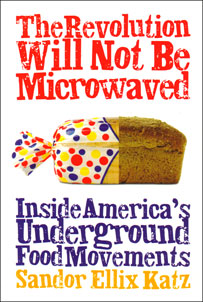
The Revolution Will Not Be Microwaved: Inside America's Underground Food Movements is a 2003 book by food activist Sandor Katz that examines how contemporary food production differs drastically from our recent past. The author challenges the corporate food industry as well as the way we think about food. He suggests how traditional cultural practices of sustainable agriculture might subvert the corporate farm system.
Jun, or Xun, is a fermented drink similar to kombucha, differing only in that its base ingredients are green tea and honey instead of black tea and cane sugar. Jun is brewed by fermenting green tea with a symbiotic culture of bacteria and yeast (SCOBY). Fruits, sweeteners, spices, and other flavor enhancers are also commonly added to make the taste of the beverage more appealing. Though Jun bears similarities to other fermented drinks like kombucha, water kefir, and kvass, it has enough differences to be considered a distinct drink.
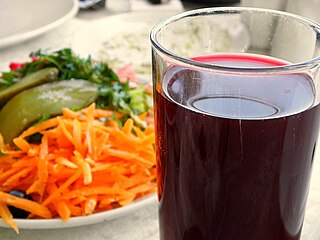
Şalgam or Şalgam Suyu, pronounced "shal-gam", is a popular Turkish traditional fermented beverage from the southern Turkish cities of Adana, Hatay, Tarsus, Mersin, Kahramanmaras, İzmir and the Çukurova region. The name of the fruit is a Persian loanword meaning turnip. It is either called turnip juice, turnip water, shalgam juice, or shalgam water. The French traveler, naturalist and writer Pierre Belon described its production method in the 16th century. Şalgam is produced by lactic acid fermentation. Studies have shown that the juice of the purple carrot used in Şalgam reduces the effects of high-carbohydrate, high-fat diets in rats. It is one of the most popular beverages during winter in Turkey.

Beer in Egypt has long held a significant role, and its presence in the country is thought to date back to the Predynastic period. In ancient Egypt wine was preferred by the upper class, whereas beer was a staple for working class Egyptians and a central part of their diet. Despite religious restrictions and conflicting views on alcohol after the Muslim conquest of Egypt, the consumption of beer did not cease, and it still remains the most popular alcoholic beverage in the country by far, accounting for 54 percent of all alcohol consumption.
















